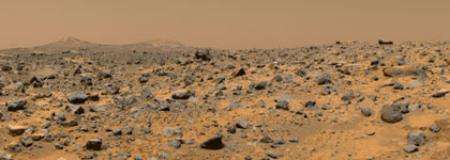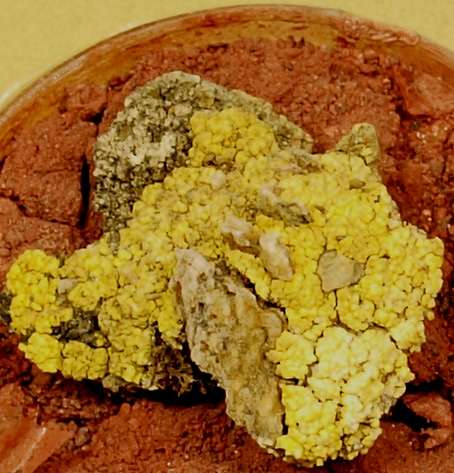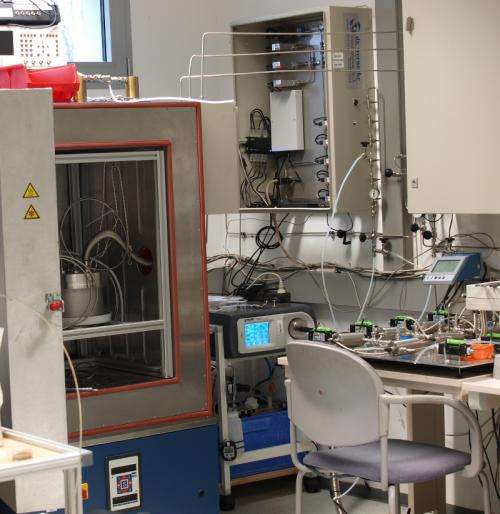Lichen on Mars

Humans cannot hope to survive life on Mars without plenty of protection from the surface radiation, freezing night temperatures and dust storms on the red planet. So they could be excused for marveling at humble Antarctic lichen that has shown itself capable of going beyond survival and adapting to life in simulated Martian conditions.
The mere feat of surviving temperatures as low as -51 degrees C and enduring a radiation bombardment during a 34-day experiment might seem like an accomplishment by itself. But the lichen, a symbiotic mass of fungi and algae, also proved it could adapt physiologically to living a normal life in such harsh Martian conditions—as long as the lichen lived under "protected" conditions shielded from much of the radiation within "micro-niches" such as cracks in the Martian soil or rocks.
"There were no studies on adaptation to Martian conditions before," said Jean-Pierre de Vera, a scientist at the German Aerospace Center's Institute of Planetary Research in Berlin, Germany. "Adaptation is very important to be investigated, because it tells you more about the interactions of life in relation to its environment."
Previous Mars simulation experiments focused on simply measuring the survival of organisms at the end of a given time period. By contrast, de Vera and his group of German and U.S. colleagues measured the lichen's activities throughout the experiment that was detailed in the Sept. issue of the journal Planetary and Space Science. They wanted to see whether the lichen had continued its normal activities rather than simply clinging to life in a dormant state.
Two groups of lichen samples were placed inside a Mars simulation chamber about the size of a big pressure cooker, which itself sat within a fridge about the size of an armoire. That allowed researchers to simulate almost everything about Martian conditions such as atmospheric chemistry, pressure, temperatures, humidity and solar radiation—the lone exceptions being Martian gravity and the added contribution of galactic radiation.
One of the lichen samples in the Mars chamber was exposed to the full brunt of radiation expected on the Martian surface, while the second set of samples received a radiation dose almost 24 times lower to simulate life in the "protected" condition. A third group of lichen samples sat outside the chamber as a control.

Both lichen sample groups survived their month-long period under Martian conditions. But the heavier dose of radiation from a Xenon lamp simulating the surface radiation conditions kept the unprotected sample group from doing much beyond clinging to survival.
Only the "protected" lichen carried on normal activities such as using photosynthesis to turn sunlight into chemical energy for itself. The protected lichen recovered quickly after an initial "shock" period by adapting well enough to steadily ramp up its photosynthetic activities all the way until the end of the experiment.
"We have shown the first time, that in particular photosynthesis is possible in micro-niches on the surface of Mars," de Vera explained.
The lichen chosen for the experiment, called P. chlorophanum, has proven itself a survival champion even before the Mars simulation. Researchers removed lichen samples for testing from its home atop the rocky Black Ridge in Antarctica's North Victoria Land—a frozen, dry landscape not unlike that of many places on Mars.
Similar lichens have shown they can survive exposure to the vacuum of space as well as space radiation. The past experiments conducted by the European Space Agency aboard Russian FOTON satellites and the International Space Station included de Vera as a co-investigator.
The latest Mars simulation experiment did not try to simulate the Martian dust storms that can blanket the entire planet for a month. But de Vera points out that lichen can survive in a resting state for thousands of years on Earth while covered with dust, snow or ice.

Lichen don't exist alone as possible Earth survivors on Mars. Other studies conducted by de Vera have suggested that methane-producing bacteria, known as methanogens, could also manage a Martian existence.
"There are important indices that Earth life can survive, to be metabolically active and adapt physiologically to live on Mars during the time periods which have been investigated," de Vera said.
The experiment's results have huge implications for ongoing robotic missions searching for evidence of life on Mars. First, they confirm that such missions would do well to focus on searching for possible Martian life within the "micro-niche" environments beneath the soil or within rocks protected from surface radiation. Second, they lend hope to the idea that Martian life—if at all similar to Earth life—could have indeed survived up until today.
The lichen's remarkable adaptation to Martian conditions suggests a third, equally important lesson—it justifies the ongoing caution of NASA and other space agencies in ensuring that Earth organisms don't accidentally hitchhike a ride to Mars. Such planetary protection measures seem likely to continue until the possible day that humanity decides to colonize Mars and perhaps change the planet's landscape in the process.
Journal information: Planetary and Space Science
Provided by Astrobio.net




















